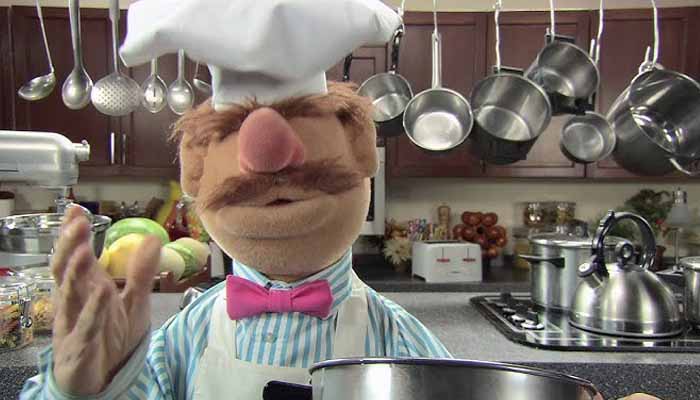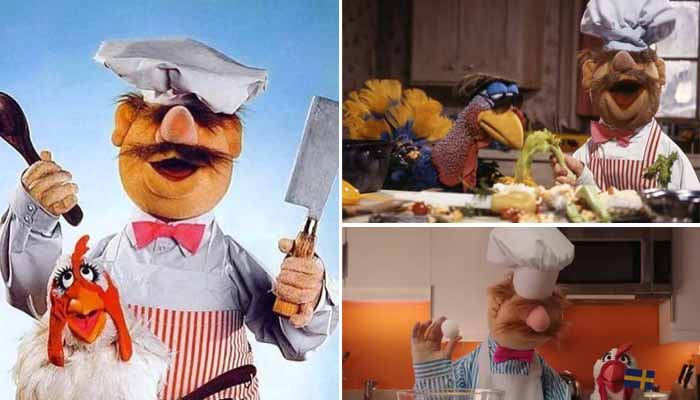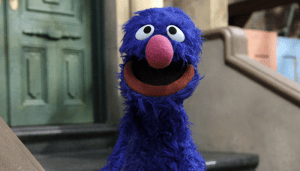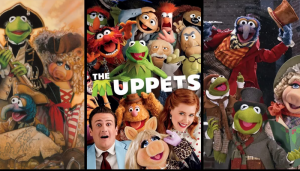The world of the Muppets is filled with iconic characters, each bringing their unique brand of humor and charm to the stage. Yet, for many, the pinnacle of Muppet comedic genius resides in the chaotic kitchen of the one and only Swedish Chef. With his towering white hat, perpetually flustered demeanor, and an utter inability to produce anything remotely edible, this beloved character has been entertaining audiences for decades. But what is it about this gibberish-speaking culinary catastrophe that continues to tickle our funny bones? Let’s delve into the origins, the hilarious highlights, and the enduring appeal of the magnificent Swedish Chef.
Who is This Børk-ing Madman? A Look at the Swedish Chef’s Origins
The Swedish Chef first burst onto our screens in 1975, not on the main stage of “The Muppet Show,” but in one of its two pilot episodes titled “Sex and Violence”. Even in this early appearance, the core of his comedic persona was already firmly established. He was there to cook, albeit in a manner that defied all logic and culinary expertise. This initial introduction laid the groundwork for his regular appearances when “The Muppet Show” officially premiered the following year. His presence quickly became a staple, making him a crucial ingredient in the show’s overall comedic recipe.
Behind the apron and oversized hat, the Swedish Chef is brought to life by a remarkable feat of puppetry. Originally, the character was a collaborative effort between the legendary Jim Henson, who operated the head and provided the iconic voice, and Frank Oz, who skillfully manipulated the Chef’s visible hands. This two-person operation is a unique aspect of the character, allowing for a greater range of physical comedy and interaction with the surrounding environment. Over the years, other talented puppeteers have taken on the role, including Bill Barretta, who currently performs the character, with Peter Linz handling the hands. A charming detail often spotted is a ring worn on one of the Chef’s hands, a mishap from early performances by Steve Whitmire and Bill Barretta that became an endearing part of the character’s visual identity.
The Swedish Chef’s most distinctive feature is undoubtedly his language, a nonsensical stream of gibberish that is supposedly “mock Swedish”. While it might sound Swedish to some, particularly with the occasional recognizable English word thrown in for context , linguistic experts suggest the intonation is actually closer to Norwegian. The creation of this unique vocal styling came from Jim Henson himself, who reportedly spent time listening to Berlitz Swedish language tapes to perfect the comedic babble. Despite claims from a real-life Swedish chef named Lars Bäckman about being the inspiration, these have been refuted by Muppets head writer Jerry Juhl, who insisted the character was not based on any specific individual. Regardless of its precise Scandinavian roots, the Swedish Chef’s language is a key component of his enduring humor.
The Art of Incomprehensible Cuisine: Decoding the Swedish Chef’s Comedic Genius

Beyond the gibberish, the Swedish Chef’s humor is built upon a foundation of memorable catchphrases and a cooking style that consistently veers into utter chaos. His most famous utterance, “Bork, bork, bork!”, is instantly recognizable and has become synonymous with the character. This phrase often punctuates his introductory song and frequently appears at the end of his skits, often accompanied by the throwing of utensils.
His cooking segments typically begin with a signature song, delivered in his trademark “mock Swedish,” while enthusiastically waving various kitchen implements. The lyrics of this song might vary slightly from episode to episode, but it almost always culminates in the iconic “Bork, bork, bork!” as he flings his utensils aside, sometimes with enough force to dislodge items from shelves or the back wall. Following this energetic introduction, the Chef embarks on preparing a dish, offering a running commentary in his unique language, interspersed with occasional English words that hint at his intended culinary goal. These English clues are often essential, as his methods and the equipment he employs are anything but conventional.
The true comedic brilliance of the Swedish Chef lies in his complete ineptitude in the kitchen and his wildly unorthodox approach to cooking. Expect to see him wielding firearms, sports equipment, or power tools in his attempts to prepare a meal. The anticipation of the absurd and the inevitable disastrous outcome is a core part of the humor. The expectation of a delicious dish is quickly replaced by the enjoyment of watching the chaotic process unfold.
The Skits That Still Make Us Laugh Out Loud
While the Swedish Chef’s entire repertoire is a masterclass in comedic cooking, some skits stand out as particularly hilarious and memorable. Here are three examples that consistently bring a smile to Muppet fans’ faces:
Pöpcørn
The simple act of making popcorn becomes an exercise in escalating absurdity in the Swedish Chef’s rendition. In various iterations of this skit, he employs increasingly outlandish methods to pop the kernels, often involving explosions, the introduction of bizarre and unexpected ingredients, and a general state of kitchen pandemonium. The humor stems from the contrast between the straightforward task and the Chef’s utterly illogical approach. Watching him battle with the seemingly simple act of making popcorn, often with subtitles that hilariously misinterpret his gibberish, is a guaranteed laugh. The visual gags and slapstick comedy as the popcorn (and often other things) flies around the kitchen contribute to the skit’s enduring popularity.
Chocolate Moose
The “Chocolate Moose” skit perfectly exemplifies the Swedish Chef’s tendency for literal interpretations and his interactions with live animals. In this classic segment, the Chef attempts to create a chocolate moose, which inevitably involves a real, live moose (or a Muppet dressed as one) being covered in chocolate. The sheer absurdity of having a moose in a kitchen, combined with the messy application of chocolate, creates a wonderfully silly scenario. The humor arises from the literal interpretation of the dish’s name and the unexpected presence of a large, furry creature amidst the pots and pans. The interaction between the Chef and the bewildered moose is a highlight, showcasing the physical comedy that the character excels at.
Chicken in the Basket
Another recurring and highly amusing skit involves the Swedish Chef’s attempts to prepare “Chicken in the Basket.” This often turns into a slapstick chase around the kitchen as the Chef tries to catch a live chicken with a cleaver. The frantic pursuit, the chicken’s panicked reactions, and the Chef’s determined yet clumsy efforts create a dynamic and highly entertaining segment. Even when he manages to capture the bird, the subsequent cooking attempts are usually fraught with peril for both the Chef and the chicken. The humor in this skit lies in the physical comedy of the chase and the ongoing struggle between the determined chef and his unwilling ingredient.
| Skit Title | Main Ingredients (Attempted) | Hilarious Outcome (Typical) | Key Comedic Elements | Relevant Snippets |
|---|---|---|---|---|
| Pöpcørn | Corn kernels | Explosions, unusual ingredients added, general kitchen chaos | Escalating absurdity, visual gags, interaction with corn | |
| Chocolate Moose | Chocolate, Moose | Messy chocolate application on a live/costumed moose | Literal interpretation, absurdity of a moose in a kitchen | |
| Chicken in Basket | Chicken, Basket | Chase scenes, chicken escaping, failed cooking attempts | Slapstick, interaction with live animal, Chef’s frustration |
Running Gags and Utensil-Throwing: The Hallmarks of a Swedish Chef Skit
Beyond specific skits, the Swedish Chef’s performances are peppered with recurring gags that contribute to his unique comedic identity. One prominent element is his frequent use of unorthodox kitchen equipment. Instead of whisks and spatulas, viewers might see him reaching for firearms, tennis rackets, or even power tools to accomplish his culinary tasks. This unexpected use of everyday objects in the context of cooking amplifies the absurdity and leads to numerous visual gags.
Another running joke involves his often comical misunderstanding or mishandling of ingredients. Whether it’s attempting to cook a live mole in a taco or using obviously fake ingredients, his interactions with food are rarely conventional and frequently hilarious. On occasion, guest stars on “The Muppet Show” would find themselves caught in the crossfire of the Swedish Chef’s culinary chaos, their reactions often adding another layer of humor to the skits.
Of course, no discussion of Swedish Chef’s running gags would be complete without mentioning the iconic utensil toss at the end of his introductory song. This simple yet effective action provides a consistent and visually funny punctuation to the beginning of his segments, setting the stage for the mayhem that is sure to follow.
Beyond the Kitchen: The Swedish Chef’s Enduring Popularity and Cultural Impact
The Swedish Chef’s appeal extends far beyond his appearances on “The Muppet Show.” He has been a consistent presence in numerous Muppet movies, television specials, and even more recent productions like “Muppets Now”. His continued inclusion in the Muppets’ world across decades speaks volumes about his lasting popularity and iconic status within the franchise.
Fans continue to find his skits funny and memorable, evidenced by online discussions, fan rankings, and the enduring affection for the character. The Swedish Chef has even transcended the realm of Muppets, making appearances on shows like “The Tonight Show with Johnny Carson” and “America’s Got Talent,” showcasing his broader cultural impact. His unique language and comedic style have also led to parodies and references in various forms of popular culture. This all points to a character who has not only entertained generations but has also become a recognizable and beloved figure in the wider cultural landscape.
Conclusion: A Toast (with Maybe Some Rubber Chicken) to the Swedish Chef
From his debut in 1975 to his continued appearances today, the Swedish Chef remains a testament to the enduring power of silly, nonsensical humor. His incomprehensible language, his chaotic cooking methods, and his signature “Bork, bork, bork!” have cemented his place as one of the most beloved and funniest Muppets of all time. So, the next time you’re looking for a good laugh, why not pull up a classic Swedish Chef skit? Just don’t expect to get any actual cooking tips – unless you’re in the market for a rubber chicken sandwich, perhaps.




